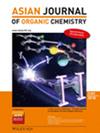铜催化氧化环化反应的研究进展
IF 2.8
4区 化学
Q1 CHEMISTRY, ORGANIC
引用次数: 0
摘要
在这篇综述中,我们概述了从2020年到现在的铜催化氧化环化反应。一般情况下,Cu(II)和Cu(I)都可以作为起始催化剂,但反应机理不同。例如,从反应机理上看,Cu(II)作为起始催化剂,往往直接与氧化剂结合,参与中间体或底物的催化氧化。当Cu(I)作为起始催化剂时,它直接促进N−O键的裂解或与炔键配合,而中间体的后续氧化则使用氧化剂。实验结果表明,大多数铜催化氧化环化策略都取得了满意的效果。本文章由计算机程序翻译,如有差异,请以英文原文为准。
Recent Advances in Copper‐Catalyzed Oxidative Cyclization Reactions
In this review, we have presented an overview on the copper‐catalyzed oxidative cyclization reactions over the period from 2020 to the present. In general, both Cu(II) and Cu(I) can be used as starting catalysts, but the reaction mechanisms were different. For example, from the perspective of reaction mechanism, as a starting catalyst, Cu(II) was often directly combined with oxidants to participate in the catalytic oxidation of intermediates or substrates. When Cu(I) served as the starting catalyst, it directly promoted the cleavage of N−O bonds or coordinated with alkyne bonds, while oxidants were used for the subsequent oxidation of intermediates. The experimental results showed that most of the copper‐catalyzed oxidative cyclization strategies have achieved satisfactory results.
求助全文
通过发布文献求助,成功后即可免费获取论文全文。
去求助
来源期刊

Asian Journal of Organic Chemistry
CHEMISTRY, ORGANIC-
CiteScore
4.70
自引率
3.70%
发文量
372
期刊介绍:
Organic chemistry is the fundamental science that stands at the heart of chemistry, biology, and materials science. Research in these areas is vigorous and truly international, with three major regions making almost equal contributions: America, Europe and Asia. Asia now has its own top international organic chemistry journal—the Asian Journal of Organic Chemistry (AsianJOC)
The AsianJOC is designed to be a top-ranked international research journal and publishes primary research as well as critical secondary information from authors across the world. The journal covers organic chemistry in its entirety. Authors and readers come from academia, the chemical industry, and government laboratories.
 求助内容:
求助内容: 应助结果提醒方式:
应助结果提醒方式:


